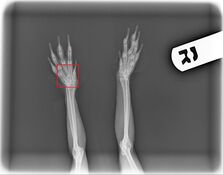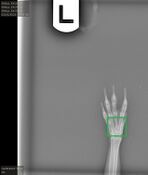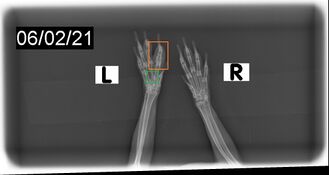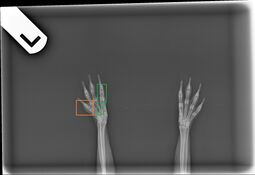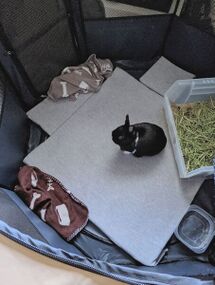Broken bones
(Redirected from Cage rest)
This article is incomplete because it lacks depth or is unfinished. Help by expanding it.
Putting a rabbit on cage rest
Consult with your rabbit's veterinarian to understand the parameters (e.g., how long, what size...) around cage rest. Failure to adhere to a cage rest regimen may worsen your rabbit's current injury and/or cause new injuries. In general, it is safer to maintain cage rest for a longer amount of time.
In the case of bone fractures or sprains, cage rest is generally recommended for at least two weeks to ensure excessive movement does not exacerbate the injury. Although cage rest requires confinement and reduces daily exercise, it is imperative to minimize recovery-related complications. Adhering to recommended cage rest will optimize and quicken recovery time so that your rabbit can return to their larger space sooner and pain-/risk-free.
Factors to consider in creating a cage rest space:
- Size: The enclosure should still be large enough to house all the necessities, including a water bowl, litter box, and some maneuvering space for your rabbit.
- Flooring: Movement should be as easy as possible, so it is crucial to provide soft and stable traction in the enclosure. A towel or fleece on top of a slippery surface will still slide and potentially lead to injury.
- Litterbox: Depending on the nature of your rabbit's injury, you may opt for a lower-lip litterbox so jumping is minimal or you may forgo a litterbox for the duration of cage rest. While there may be concerns about litterbox adherence, the priority is a smooth recovery, so easy access to hay is more important for the foreseeable future.
- Engagement: There should be no jumping platforms or items in the enclosure that will encourage intense exercise, especially digging if your rabbit's injury involves either front paws. You may need to provide low-intensity engagement activities (ex. hay toppers, scatter-feeding pellets...) that can keep your rabbit entertained without requiring excessive physical exertion.
Experiences
The following are some stories about rabbits with broken bones.
- u/polkadottedelephant. (2024). 6.5-year-old lop broke her jaw
- u/GrrLikeTiger. (2022). 5-month-old Continental Giant with tibia fracture after 6 weeks of healing
- House Rabbit Society Singapore (HRSS). (2022). Pickles's experience with a hind leg fracture
- Petplan. (2021). We’ll never know exactly what happened – how my rabbit overcame a broken leg
- New Beginnings Animal Rescue. (2021). Baby Evie was found with a broken leg and needs funds to pin the break
- The Unusual Pet Vets. (2021). A leg amputation for Archie due to severely broken bones after a fight with brother (Graphic)
- Zooh Corner Rabbit Rescue. (2021). Story of Snow Cone Jones, a baby rabbit with a broken back
- Wick & Fable. (2021). Front Paw Fracture experience
- Bird and Exotic Animal Clinic. (2018). Facebook video about Gnocchi who had a broken neck
- Pete the Vet. (2017). Lily the rabbit had a problem with her leg
- katk. (2016). Rabbit with broken right hind hock/calcaneus
- Pete the Vet. (2015). Bongy, a 5 month old rabbit who broke his back leg.
- seachelle. (2014). 9-month-old rabbit with broken pelvis
- Phoenixfyre. (2013). 6-month-old rabbit with broken right hind leg
- u/s_pete. (2012). Rabbit broke her hip/pelvis and was put on strict cage rest for 2.5 months
- D. Tomlin. (2011). Story: Rabbit with broken jaw – healing without repair surgery
- V. Sjöberg. Ventro-dorsal radiography of the left hind foot with a broken toe
Further reading
- Ashley Clayton BVSc MRCVS. (2021). How are broken legs treated in rabbits?
- Frances Harcourt-Brown. The dilemma of a rabbit with a broken leg
- Esther van Praag Ph.D. Limb fracture and pinning of the broken bone (Graphic)


